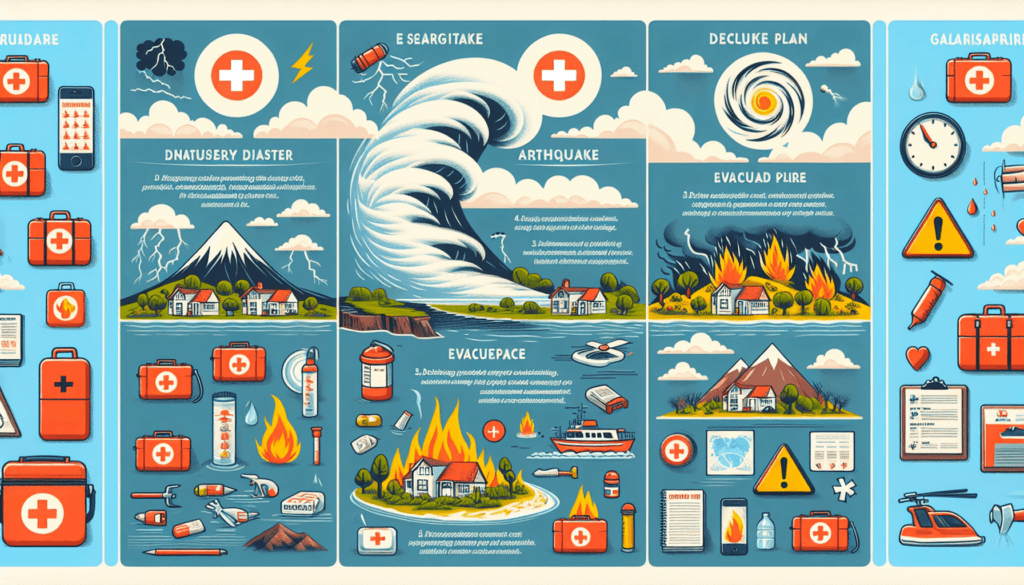In today’s unpredictable world, being prepared for natural disasters is of paramount importance. The name of the game is readiness, and in “Be Ready, Stay Safe: A Guide to Natural Disaster Preparedness,” you will find a comprehensive resource to equip yourself with the necessary knowledge and tools to face any unforeseen event head-on. From hurricanes to earthquakes, this article will provide you with essential tips and strategies to ensure your safety, the safety of your loved ones, and the security of your property. Brace yourself for a journey of preparedness that will empower you to take charge in the face of adversity.
Table of Contents
Understanding Natural Disasters
Natural disasters are events that result from natural processes and can cause significant damage, loss of life, and disruption to our daily lives. It is crucial to have a comprehensive understanding of the different types of natural disasters, their causes, and the risks associated with them. By doing so, we can take the necessary steps to protect ourselves, our homes, and our communities.
Be Ready, Stay Safe: A Guide to Natural Disaster Preparedness
Types of natural disasters
Natural disasters come in various forms, each with its own unique characteristics and potential for devastation. Some of the most common types of natural disasters include earthquakes, floods, hurricanes, tornadoes, wildfires, and tsunamis. Understanding the specific nature of each type of disaster is essential for developing effective preparedness strategies.
Causes of natural disasters
Natural disasters can be caused by a combination of factors, including geological processes, climatic conditions, and human activities. Earthquakes, for example, result from the movement of tectonic plates beneath the Earth’s surface, while floods often occur due to heavy rainfall or the overflowing of rivers. It is essential to recognize the root causes of these disasters to better comprehend their likelihood and prepare accordingly.
Understanding the risks
To effectively prepare for natural disasters, it is critical to assess the risks associated with your location and the specific types of disasters that are prevalent in your area. Conducting a thorough risk analysis will help you identify the potential hazards and vulnerabilities in your surroundings. This knowledge will enable you to prioritize your preparedness efforts and take appropriate actions to mitigate the impact of future disasters.
Creating an Emergency Plan
Creating an emergency plan is a fundamental component of disaster preparedness. It involves considering potential hazards, developing a communication plan, and establishing meeting points to ensure the safety and well-being of yourself, your loved ones, and your community during a crisis.

Identifying potential hazards
Start by identifying the specific hazards that are prevalent in your area. Research the history of natural disasters in your region to gain insights into the types of events that have occurred in the past. This information will serve as a foundation for understanding the potential risks you may face and allow you to tailor your emergency plan accordingly.
Developing a communication plan
Communication is crucial during times of crisis, and having a well-thought-out communication plan can make a significant difference in ensuring the safety of everyone involved. Establish a reliable method of communication with your family members, friends, and neighbors. Identify key contacts both within and outside your immediate area to relay important information or seek assistance if needed.
Establishing meeting points
In the event of an emergency, it is essential to have pre-determined meeting points where you can reunite with your family members or other individuals you are responsible for. These meeting points should be easily accessible, away from potential hazards, and well-known to everyone involved. Having designated meeting points will help facilitate a swift and organized response during a crisis.
Building an Emergency Kit
Building an emergency kit is a vital step in disaster preparedness. It ensures that you have essential supplies readily available in case of an emergency. Your emergency kit should include water and food supplies, a first-aid kit, important documents, cash, and other necessary items.

Water and food supplies
Water is an essential resource during emergencies, and it is recommended to store at least one gallon of water per person per day for a minimum of three days. Non-perishable food items should also be included in your emergency kit, such as canned goods, energy bars, and dried fruits. Ensure that you regularly check and replenish your food and water supplies to maintain their freshness and usability.
First-aid kit and medications
Having a well-stocked first-aid kit is crucial to address any injuries or medical emergencies that may occur during a disaster. The kit should include items such as bandages, antiseptic ointments, pain relievers, and any necessary prescription medications. Make sure to periodically review and update the contents of your first-aid kit, including checking the expiration dates of medications.
Important documents and cash
Having copies of important documents, such as identification papers, insurance policies, and medical records, is essential for navigating the aftermath of a natural disaster. Keep these documents in a waterproof and portable container, readily accessible in case of evacuation. It is also advisable to have some cash on hand, as electronic payment systems may be unavailable during and after a disaster.
Securing Your Home
Securing your home is a critical step in disaster preparedness. By reinforcing structures, installing safety devices, and managing utilities, you can minimize the potential damage and protect yourself and your loved ones during a natural disaster.

Reinforcing structures
Evaluate your home’s structural integrity and take necessary measures to reinforce weak areas. This may involve securing heavy furniture and appliances, reinforcing doors and windows, and strengthening the roof. Consult with professionals or refer to local building codes for guidance on specific reinforcement techniques suitable for your area and the prevalent types of natural disasters.
Installing safety devices
Install safety devices to mitigate the risks associated with different types of natural disasters. For instance, consider purchasing and installing fire alarms, smoke detectors, and carbon monoxide detectors to enhance early detection and warning in case of a fire or other related emergencies. Additionally, having a functioning and regularly tested emergency generator can provide essential backup power during extended power outages.
Managing utilities
Familiarize yourself with the location and operation of utility shut-off valves, such as gas, water, and electricity. In the event of an emergency, knowing how to safely shut off these utilities can prevent potential hazards and further damage. Regularly inspect your utility systems and address any maintenance issues promptly to ensure their reliability and functionality during a crisis.
Preparing Your Pets
When preparing for natural disasters, it is essential not to overlook the needs of your pets. Creating a pet emergency kit, identifying pet-friendly shelters, and ensuring proper identification for your furry companions are crucial steps in ensuring their safety during a disaster.

Creating a pet emergency kit
Just like you would prepare an emergency kit for yourself, it is important to have one for your pets as well. Include items such as food, water, a leash, a pet carrier, medications, and any necessary medical records. Familiarize yourself with your pet’s specific needs and ensure you have enough supplies to sustain them for an extended period of time.
Identifying pet-friendly shelters
Not all shelters or evacuation centers are pet-friendly, so it is crucial to identify pet-friendly options in advance. Research local shelters or hotels that allow pets during emergencies and keep their contact information readily available. Planning ahead will enable you to secure a safe place for your pets in case evacuation becomes necessary.
Ensuring proper identification
In the event of a disaster, pets can easily become separated from their owners. Ensure your pets have proper identification, such as a collar with an updated tag or a microchip. Having a current photograph of your pets can also aid in their identification and eventual reunion with you if they become lost during a crisis.
Evacuation Planning
In certain situations, evacuation may be necessary to ensure your safety and well-being. Understanding evacuation routes, preparing a go-bag, and considering transportation options are crucial steps in effective evacuation planning.

Understanding evacuation routes
Familiarize yourself with the designated evacuation routes in your area. These routes are pre-determined by local authorities and provide the safest and most efficient paths to take during an evacuation. Stay informed about any updates or changes to these routes and plan alternative paths if necessary.
Preparing a go-bag
A go-bag, also known as a survival kit or emergency bag, is a portable collection of essential items that you can quickly grab and take with you during an evacuation. Your go-bag should include items such as water, non-perishable food, a first-aid kit, important documents, cash, extra clothing, and any necessary medications. Keep your go-bag easily accessible and regularly update its contents to meet your changing needs.
Considering transportation options
When developing your evacuation plan, consider the transportation options available to you. If you have a personal vehicle, ensure it is well-maintained and that you have enough fuel to reach your desired destination. If you do not own a vehicle or anticipate difficulties in using it during an evacuation, familiarize yourself with alternative transportation options, such as public transportation or coordinating with neighbors.
Staying Informed
Staying informed is crucial for effective disaster preparedness. Monitoring weather updates, signing up for emergency alerts, and using reliable information sources will ensure that you have the most accurate and up-to-date information during a crisis.
Monitoring weather updates
Stay tuned to local news channels, meteorological agencies, and official weather websites to stay informed about changing weather conditions. Regularly check weather reports and forecasts to anticipate potential natural disasters and take appropriate action. Consider using weather apps or subscribing to weather alert services to receive real-time updates directly to your mobile devices.
Signing up for emergency alerts
Many municipalities and emergency management agencies provide emergency alert systems to notify residents about potential threats or disaster situations. Sign up for these alert systems to receive important information, warnings, and instructions directly from authorities. These alerts can be delivered via text messages, phone calls, emails, or through dedicated mobile applications.
Using reliable information sources
During times of crisis, it is crucial to rely on trusted and reliable information sources. Be cautious of spreading or consuming unverified information that can cause panic and confusion. Refer to official government websites, reputable news outlets, and trusted emergency management organizations to ensure you are accessing accurate and credible information that can guide your preparedness and response efforts.
Caring for Vulnerable Populations
When preparing for natural disasters, it is essential to consider the specific needs of vulnerable populations within your community. This includes elderly and disabled individuals, children and infants, and people with medical conditions. By addressing their unique requirements, you can better ensure their safety and well-being during a crisis.
Elderly and disabled individuals
Elderly and disabled individuals may have limited mobility, access, or special medical needs. When developing your emergency plan, consider how you can assist them in evacuating, accessing necessary supplies, and addressing any medical concerns. Collaborate with local support services and healthcare providers to identify resources and assistance available to elderly and disabled members of your community.
Children and infants
Children, especially infants, require specific attention and care during emergencies. Ensure that you have sufficient supplies for their needs, including diapers, formula, medications, and comfort items. Develop a communication plan with their schools or childcare providers, and educate older children on what to do in case of an emergency. Stay informed about child-friendly shelters and services available in your area.
People with medical conditions
People with medical conditions often have unique requirements during emergencies. If you or someone in your household has a medical condition, ensure that you have an adequate supply of necessary medications and medical equipment readily available. Establish a communication plan with healthcare providers and consider registering with local medical support services to ensure priority assistance during emergencies.
Post-Disaster Recovery
Recovering from a natural disaster is an ongoing process that involves assessing damages, seeking assistance, and addressing emotional well-being. It is important to remember that recovery takes time and requires patience, resilience, and community support.
Assessing damages
After a disaster, conduct a thorough assessment of the damages to your property. Take photographs or videos to document the extent of the damage for insurance claims. If necessary, consult with professionals, such as engineers or contractors, to assess the structural integrity of your home or any potential hazards that may be present.
Seeking assistance
In the aftermath of a natural disaster, seek assistance from government agencies, non-profit organizations, and community resources. These entities often provide financial aid, temporary housing, disaster debris removal services, and other forms of assistance to help individuals and communities rebuild and recover. Familiarize yourself with available resources in advance to expedite the process of seeking assistance if needed.
Addressing emotional well-being
Natural disasters can have a profound impact on the emotional well-being of individuals and communities. Understand that it is normal to experience a range of emotions, including fear, anxiety, and grief, during and after a disaster. Reach out to local support groups, mental health professionals, or community organizations that offer counseling services. Engage in self-care practices and maintain social connections to foster resilience and healing during the recovery process.
Community Preparedness
Effective disaster preparedness extends beyond individual efforts and encompasses the broader community. By joining local emergency response groups, participating in drills and exercises, and educating others on disaster preparedness, you can contribute to building a resilient and cohesive community.
Joining local emergency response groups
Become an active participant in local emergency response groups or organizations that focus on disaster preparedness and response. These groups often offer training, community outreach programs, and opportunities to contribute to disaster planning initiatives. By working together with your neighbors and local authorities, you can enhance community resilience and response capabilities.
Participating in drills and exercises
Take advantage of opportunities to participate in drills and exercises conducted by local emergency management agencies or community organizations. These simulations simulate disaster scenarios and test emergency response procedures. By actively engaging in these exercises, you can familiarize yourself with the appropriate actions to take during emergencies, identify areas for improvement, and enhance your overall preparedness.
Educating others on disaster preparedness
Share your knowledge and experiences with others in your community by educating them on the importance of disaster preparedness. Organize or participate in workshops, community meetings, or awareness campaigns that promote disaster resilience and preparedness. Encourage your friends, family, and neighbors to develop their emergency plans, assemble emergency kits, and stay informed about potential risks in your area.
In conclusion, preparedness is the key to effectively mitigating the impact of natural disasters. By understanding the types of natural disasters, their causes, and the risks associated with them, we can tailor our emergency plans and take the necessary steps to protect ourselves, our loved ones, and our communities. Creating an emergency plan, building an emergency kit, securing our homes, preparing our pets, and staying informed are all critical components of disaster preparedness. Additionally, caring for vulnerable populations, engaging in post-disaster recovery, and fostering community preparedness can help build resilience and promote a safer and more sustainable future. Remember, being ready and staying safe starts with thorough and proactive planning.
Related site – Disaster Preparedness Tips

